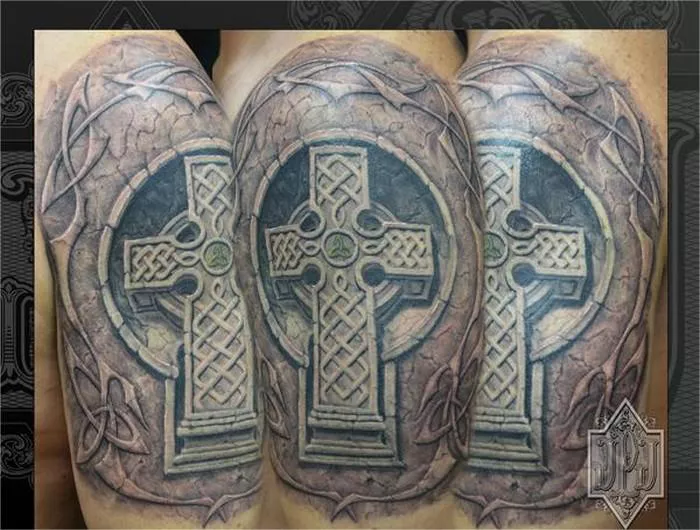The Celts, an ancient Indo-European people, have long captured the imagination with their rich cultural tapestry, fierce warrior ethos, and enigmatic symbols. Among the many questions that arise when delving into Celtic history and culture, one particularly intriguing inquiry persists: Did Celtic warriors adorn themselves with tattoos? The answer to this question is multifaceted, drawing upon archaeological evidence, historical accounts, and cultural interpretations.
Ancient Celts: A Brief Overview:
Before delving into the question of Celtic tattoos, it is essential to establish a foundational understanding of who the Celts were. The Celts were a diverse group of tribes inhabiting regions of Europe during the Iron Age, with their influence spanning from the British Isles to modern-day Turkey. They were renowned for their craftsmanship, intricate artistry, and fierce independence. Celtic society was hierarchical, with warriors holding esteemed positions and playing a central role in both warfare and community life.
Archaeological Evidence:
One avenue of inquiry into the existence of Celtic tattoos lies in archaeological discoveries. Over the centuries, excavations across Celtic-inhabited territories have unearthed a wealth of artifacts, including ancient human remains adorned with elaborate designs. Among these findings are mummified bodies preserved in peat bogs, such as the famous “Lindow Man” discovered in England, whose skin bore evidence of pigment application.
Analysis of these remains has revealed intricate patterns and symbols etched into the skin, suggesting the practice of tattooing or possibly scarification among ancient Celts. However, it is crucial to note that not all preserved bodies exhibit such markings, indicating that tattooing may not have been ubiquitous across Celtic society.
Historical Accounts:
In addition to archaeological evidence, historical accounts offer insight into Celtic practices, including potential tattooing customs. Greek and Roman writers, such as Julius Caesar and Strabo, provide valuable descriptions of Celtic life and culture. Caesar, in his “Gallic Wars,” mentions the Celts’ fondness for body adornment, including the use of woad (a blue dye) to paint their bodies before battle.
While these accounts shed light on Celtic aesthetics and grooming practices, they do not provide definitive evidence of tattooing specifically. Interpretation of ancient texts requires careful consideration of cultural bias and linguistic nuances, as well as the limitations of secondhand observations.
Cultural Interpretations:
Beyond the realm of physical evidence and historical documentation, scholars and enthusiasts alike have offered cultural interpretations regarding Celtic tattooing practices. Many proponents argue that tattooing held significant ritualistic and symbolic value for the Celts, serving as markers of identity, status, and spiritual beliefs.
Symbols commonly associated with Celtic art, such as spirals, knots, and animal motifs, are believed to have held deep meaning within Celtic cosmology. It is theorized that tattoos incorporating these symbols may have been used to invoke protection, signify tribal affiliations, or commemorate important life events.
Furthermore, some interpretations suggest that Celtic tattoos were not solely for decorative purposes but also served practical functions. In a society where warfare was a constant reality, tattoos may have conveyed messages of intimidation, bravery, or allegiance on the battlefield.
The Debate Continues:
Despite centuries of scholarly inquiry and fascination, the question of whether Celtic warriors had tattoos remains a subject of debate and speculation. While archaeological discoveries provide tantalizing glimpses into the past, they do not offer conclusive proof of widespread tattooing practices among the Celts.
Historical accounts offer valuable insights but must be approached with caution, considering the biases and limitations inherent in ancient texts. Cultural interpretations provide fertile ground for exploration but require careful consideration of context and evidence.
Ultimately, the truth may lie somewhere between the realms of evidence and imagination, reminding us of the complexity and mystery surrounding the ancient Celts and their enigmatic legacy. Whether adorned with ink or not, Celtic warriors continue to captivate our imaginations, their stories woven into the fabric of history and myth.
Conclusion:
The question of whether Celtic warriors had tattoos serves as a gateway into the rich tapestry of Celtic culture, inviting us to explore the intersections of art, identity, and tradition. While conclusive evidence may remain elusive, the pursuit of knowledge continues to fuel our fascination with the ancient Celts and their enduring legacy.
As we unravel the mysteries of the past, we are reminded that history is not static but rather a dynamic tapestry shaped by interpretation and discovery. Whether through archaeological excavations, historical accounts, or cultural interpretations, the quest to understand Celtic tattoos offers a glimpse into the complexities of ancient societies and the enduring allure of their enigmatic symbols.

